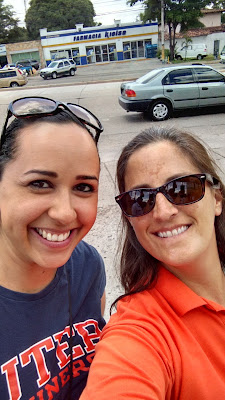Things got a bit hectic during the last few weeks in Honduras and it has taken me a while to get situated at home again. I do want to take the time to finish up on our activities, so this is the first of at least three that will summarize what we did in September and what we are planning to do in the future.
===============================================
The first few days of September were pretty eventful. Our UTEP-UPi team had the opportunity to be on TV and in the newspaper. On September 1, Clara and I received word that we would be picked up in the morning to go to Televisión Educativa Nacional, TEN Canal 10 along with Luis Eveline to talk about our project. This was pretty exciting nerve-wracking for us (or maybe only nerve-wracking for me since I don't speak Spanish). The show we were on is live and unscripted. So, even though I had some prepared remarks that I was fully capable of reading, it didn't matter.
 |
| Clara and Me - Waiting outside the TV station |
We arrived with a few minutes to spare for our appointment. After waiting for a while, we were told that we would have to come back another day because there was an important political event that was being covered live and they weren't going to do the regular show. While this was disappointing, it was somewhat relieving because that would mean that I could practice with Clara a bit more and be more comfortable.
We asked to go to the restroom and were led through a room where a movie or TV scene was about to be filmed. I really wish that I had a camera to take a picture. The actors were dressed up kind of like the actors in the 10 commandments movie and the green screen setup looked like the desert someplace. I was having fun watching the monitors, which showed how the actors and scene were combined. I have no idea what they were filming. Too bad.
After a bit more waiting, we were told that the show would go on and we were escorted upstairs. My heart was racing. The final bits of the political event were still live, so while we were getting our microphones and places, we got to hear the speech from one of the candidates for president. She was pretty interesting to listen to. I'll be curious to watch how the elections go. Then, we went live. Things moved very fast. It was cool to watch how they went from the offsite event, to weather, to announcements, and then to us. It was a crazy time. I forgot all Spanish. Watching the video now, without cameras, I understand more, but at the time I forgot every word I know. Clara did very well. I struggled with whether I would include the link because of my embarrassment, but it was a good opportunity and so I am including it here for you.
 |
| We had a few minutes, so why not take a selfie with one of the anchors? (photo credit: Clara Borrego) |
On September 2, we hosted a group of important players in Honduras water and agriculture at our pilot site. This included representatives from the USAID Honduras Mission, SANAA, Fundación Para el Desarrollo Municipal, Federación Nacional de Agricultores y Ganaderos de Honduras, Secretaría de Agricultura y Ganadería Honduras, Asociación de Municipios de Honduras, Programa de Agua del Banco Mundial, and others invited by Ing. Luis Eveline.
The event was held on a day where we (thankfully) had no rain, but also, we had full sun and very little cloud cover, so it was HOT. The event started with Ing. Luis providing a warm welcome to the visitors and introductions of the key people present. Also present was Ari Herrera, who is part of our project team. Ari and Dr. Shane Walker went to graduate school together at UT-Austin and he (Ari) is the connection we (UTEP) had to UPi and Honduras. Ari is originally from Honduras and has extensive experience in water and wastewater treatment. Ari is also very skilled at acting as a translator. He stood by me and translated key portions of comments made by participants and also translated what I said to the group. (note to self: learn more Spanish...).
 |
| Group picture with me talking (photo credit: Victor Zepeda) |
 |
Everyone loves our recovered gypsum!
(I think Victor took this photo, but I don't remember...) |
After a round robin of comments, we took the group to the well, then provided tours of the desalination and enhanced evaporation/salt recovery systems. La Tribuna, a Honduras newspaper, arrived towards the end of the tours and they interviewed our team and took some great pictures. Their article appeared in the paper the next day. They did a nice job covering the event and I am pleased that we could get such great national coverage to present our project to Honduras.






















